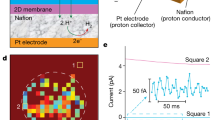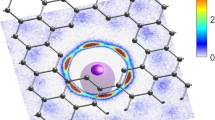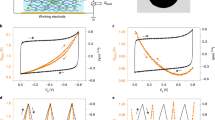Abstract
Graphene and other two-dimensional materials offer a new class of ultrathin membranes that can have atomically defined nanopores with diameters approaching those of hydrated ions1,2,3,4,5,6,7. These nanopores have the smallest possible pore volumes of any ion channel, which, due to ionic dehydration8 and electrokinetic effects9, places them in a novel transport regime and allows membranes to be created that combine selective ionic transport10 with ultimate permeance11,12,13 and could lead to separations14,15 and sensing16 applications. However, experimental characterization and understanding of sub-continuum ionic transport in nanopores below 2 nm is limited17,18. Here we show that isolated sub-2 nm pores in graphene exhibit, in contrast to larger pores, diverse transport behaviours consistent with ion transport over a free-energy barrier arising from ion dehydration and electrostatic interactions. Current–voltage measurements reveal that the conductance of graphene nanopores spans three orders of magnitude8 and that they display distinct linear, voltage-activated or rectified current–voltage characteristics and different cation-selectivity profiles. In rare cases, rapid, voltage-dependent stochastic switching is observed, consistent with the presence of a dissociable group in the pore vicinity19. A modified Nernst–Planck model incorporating ion hydration and electrostatic effects quantitatively matches the observed behaviours.
This is a preview of subscription content, access via your institution
Access options
Subscribe to this journal
Receive 12 print issues and online access
$259.00 per year
only $21.58 per issue
Buy this article
- Purchase on Springer Link
- Instant access to full article PDF
Prices may be subject to local taxes which are calculated during checkout




Similar content being viewed by others
References
Russo, C. J. & Golovchenko, J. A. Atom-by-atom nucleation and growth of graphene nanopores. Proc. Natl Acad. Sci. USA 109, 5953–5957 (2012).
Yamada, Y. et al. Subnanometer vacancy defects introduced on graphene by oxygen gas. J. Am. Chem. Soc. 136, 2232–2235 (2014).
Lv, R. et al. Nitrogen-doped graphene: beyond single substitution and enhanced molecular sensing. Sci. Rep. 2, 586 (2012).
Sint, K., Wang, B. & Král, P. Selective ion passage through functionalized graphene nanopores. J. Am. Chem. Soc. 130, 16448–16449 (2008).
He, Z., Zhou, J., Lu, X. & Corry, B. Bioinspired graphene nanopores with voltage-tunable ion selectivity for Na+ and K+. ACS Nano 7, 10148–10157 (2013).
O'Hern, S. C. et al. Selective ionic transport through tunable subnanometer pores in single-layer graphene membranes. Nano Lett. 14, 1234–1241 (2014).
Zhao, S., Xue, J. & Kang, W. Ion selection of charge-modified large nanopores in a graphene sheet. J. Chem. Phys. 139, 114702 (2013).
Suk, M. E. & Aluru, N. R. Ion transport in sub-5-nm graphene nanopores. J. Chem. Phys. 140, 084707 (2014).
Luchinsky, D., Tindjong, R., Kaufman, I., McClintock, P. & Eisenberg, R. Self-consistent analytic solution for the current and the access resistance in open ion channels. Phys. Rev. E 80, 021925 (2009).
Laio, A. & Torre, V. Physical origin of selectivity in ionic channels of biological membranes. Biophys. J. 76, 129–148 (1999).
Suk, M. E. & Aluru, N. R. Molecular and continuum hydrodynamics in graphene nanopores. RSC Adv. 3, 9365–9372 (2013).
Celebi, K. et al. Ultimate permeation across atomically thin porous graphene. Science 344, 289–292 (2014).
Surwade, S. P. et al. Water desalination using nanoporous single-layer graphene. Nature Nanotech. 10, 459–464 (2015).
Cohen-Tanugi, D. & Grossman, J. C. Water desalination across nanoporous graphene. Nano Lett. 12, 3602–3608 (2012).
O'Hern, S. C. et al. Selective molecular transport through intrinsic defects in a single layer of CVD graphene. ACS Nano 6, 10130–10138 (2012).
Clarke, J. et al. Continuous base identification for single-molecule nanopore DNA sequencing. Nature Nanotech. 4, 265–270 (2009).
Walker, M. I., Weatherup, R. S., Bell, N. A. W., Hofmann, S. & Keyser, U. F. Free-standing graphene membranes on glass nanopores for ionic current measurements. Appl. Phys. Lett. 106, 023119 (2015).
Garaj, S. et al. Graphene as a subnanometre trans-electrode membrane. Nature 467, 190–193 (2010).
Kasianowicz, J. J. & Bezrukov, S. M. Protonation dynamics of the alpha-toxin ion channel from spectral analysis of pH-dependent current fluctuations. Biophys. J. 69, 94–105 (1995).
Neher, E. & Sakmann, B. Single-channel currents recorded from membrane of denervated frog muscle-fibers. Nature 260, 799–802 (1976).
Boutilier, M. S. H. et al. Implications of permeation through intrinsic defects in graphene on the design of defect-tolerant membranes for gas separation. ACS Nano 8, 841–849 (2014).
Wells, D. B., Belkin, M., Comer, J. & Aksimentiev, A. Assessing graphene nanopores for sequencing DNA. Nano Lett. 12, 4117–4123 (2012).
Schneider, G. F. et al. DNA translocation through graphene nanopores. Nano Lett. 10, 3163–3167 (2010).
Merchant, C. A. et al. DNA translocation through graphene nanopores. Nano Lett. 10, 2915–2921 (2010).
Kosińska, I. D. How the asymmetry of internal potential influences the shape of I–V characteristic of nanochannels. J. Chem. Phys. 124, 244707 (2006).
Burger, M., Eisenberg, R. S. & Engl, H. W. Inverse problems related to ion channel selectivity. SIAM J. Appl. Math. 67, 960–989 (2007).
Chung, S., Anderson, O. S. & Krishnamurthy, V. V. (eds.) Biological Membrane Ion Channels: Dynamics, Structure, and Applications (Springer, 2007).
Chui, J. K. W. A New Paradigm for Voltage-Clamp Studies of Synthetic Ion Channels PhD thesis, Univ. Victoria (2011).
Bezrukov, S. M. & Kasianowicz, J. J. Current noise reveals protonation kinetics and number of ionizable sites in an open protein ion channel. Phys. Rev. Lett. 70, 2352–2355 (1993).
Jain, T., Aernecke, M., Liberman, V. & Karnik, R. High resolution fabrication of nanostructures using controlled proximity nanostencil lithography. Appl. Phys. Lett. 104, 083117 (2014).
Lin, Y.-C. et al. Clean transfer of graphene for isolation and suspension. ACS Nano 5, 2362–2368 (2011).
Jain, T., Guerrero, R. J. S., Aguilar, C. A. & Karnik, R. Integration of solid-state nanopores in microfluidic networks via transfer printing of suspended membranes. Anal. Chem. 85, 3871–3878 (2013).
Acknowledgements
This work was supported by the US Department of Energy, Office of Basic Energy Sciences under award no. DE-SC0008059. The research made use of the Materials Research Science and Engineering Centers Shared Experimental Facilities supported by the National Science Foundation under award no. DMR-0819762 at the Massachusetts Institute of Technology. Scanning transmission electron microscopy was conducted at Oak Ridge National Laboratory's Center for Nanophase Materials Sciences (CNMS), which is a US Department of Energy, Office of Science User Facility.
Author information
Authors and Affiliations
Contributions
T.J. and R.K. designed the experiments and wrote the manuscript. T.J., B.C.R. and R.J.S.G. performed ionic transport measurements. T.J., R.K. and M.S.H.B. developed the theoretical model and T.J. performed data analysis. S.C.O. and J.C.I. performed the scanning transmission electron microscopy experiments, and M.S.H.B compiled the histogram.
Corresponding author
Ethics declarations
Competing interests
R.K. declares financial interest in a start-up company that aims to commercialize graphene membranes.
Supplementary information
Supplementary information
Supplementary Information (PDF 8521 kb)
Rights and permissions
About this article
Cite this article
Jain, T., Rasera, B., Guerrero, R. et al. Heterogeneous sub-continuum ionic transport in statistically isolated graphene nanopores. Nature Nanotech 10, 1053–1057 (2015). https://doi.org/10.1038/nnano.2015.222
Received:
Accepted:
Published:
Issue Date:
DOI: https://doi.org/10.1038/nnano.2015.222
This article is cited by
-
An Air-Rechargeable Zn Battery Enabled by Organic–Inorganic Hybrid Cathode
Nano-Micro Letters (2023)
-
Biomimetic KcsA channels with ultra-selective K+ transport for monovalent ion sieving
Nature Communications (2022)
-
Selective transport of water molecules through interlayer spaces in graphite
Nature Communications (2022)
-
Multifunctional graphene heterogeneous nanochannel with voltage-tunable ion selectivity
Nature Communications (2022)
-
Molecular size-dependent subcontinuum solvent permeation and ultrafast nanofiltration across nanoporous graphene membranes
Nature Nanotechnology (2021)



